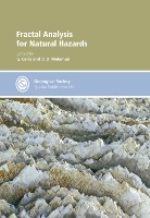Fractal Analysis for Natural Hazards
Geological Society Special Publication 261

Cello, G and Malamud, B D (eds)
Published by: The Geological Society of London
Publication date: 2006.
ISBN: 1-86239-201-3 (hbk)
List price: £75.00; GSL Member price: £37.50
172 pp
www.geolsoc.org.uk/bookshop
A fractal is an object (e.g. fracture pattern in a rock) made up of parts which are similar to the whole in some way, either exactly the same or statistically similar, except for their size. Their occurrence is characterised by a power-law size-frequency distribution in which the number of observed objects N of size ≥A, is
N=cA-D , where c is a constant of proportionality and D is a non-integer constant (which may, in some circumstances, gradually change with time). The classic example is the measured length of a coastline as a function of ruler-size (Richardson, 1960). His work was developed by Mandelbrot (1967, 1982), who coined the term 'fractal' in 1975 - D being the fractal (fractional) dimension. Since then, many phenomena in the earth sciences have been shown to exhibit such behaviour. Despite several books on this topic, this is the first to be specifically concerned with natural-hazard phenomena.
Following a useful introductory paper by Malamud and Turcotte, this interesting book brings together 11 case-histories from studies of: earthquake magnitudes, areas occupied by landslides, micro-scale crack growth in granitic rocks, outcrop-scale fracture patterns, the time-related behaviour of acoustic-emissions as a monitoring device for fracture-growth and seismicity, the movement behaviour of unstable rock slopes, extreme flood-frequency and the areas of wildfire burn-outs. Four of these studies concern aspects of monitoring seismicity in Italy or Greece. Of more theoretical interest are: Malamud and Turcotte's discussion of the suitability of cellular-automata and inverse-cascade models for modelling such phenomena; Davy
et al. on flow through fracture networks; Turcotte et al.'s suggestion that a three-parameter inverse-gamma distribution (which exhibits a power-law upper tail) appears to be a good general model for landslide-area size distributions; and Kidson et al.'s finding that a power-law model appears to make a better predictor of extreme flood magnitude than does the officially-mandated, and therefore widely-used, Log Pearson III distribution. Although one paper uses colour illustrations to good effect, the clarity of several of the graphs and maps in the book would have been greatly improved had colour been used, rather than appearing in a variety of all too similar grey-tones.
This book will reinforce the view of 'the fractal geometry of nature' (Mandelbrot, 1982). It should be of interest to all working in natural hazards research, and to final-year undergraduate and doctoral earth-science students.
References:
Mandelbrot, B. 1967. How long is the coast of Britain? Statistical self-similarity and fractional dimension. Science, 156, 636-638.
Mandelbrot, B.1982. The Fractal Geometry of Nature. W H Freeman, San Francisco.
Richardson, L. F. 1960. The problem of contiguity. General Systems. Yearbook of the Society for General Systems Research, 5, 139-187.
Richard J Howarth
University College London